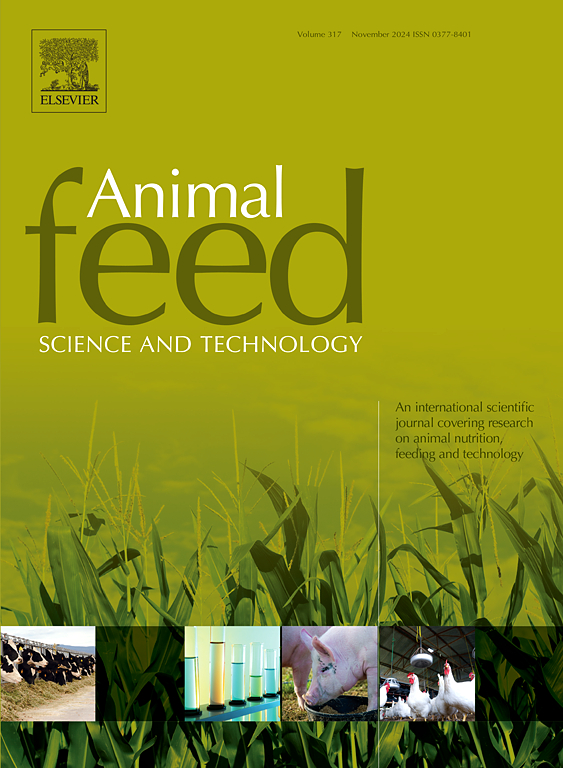接种剂对苜蓿青贮的影响:一项多组学分析揭示了微生物群落和代谢变化,尽管发酵质量不理想
IF 2.5
2区 农林科学
Q1 AGRICULTURE, DAIRY & ANIMAL SCIENCE
引用次数: 0
摘要
乳酸菌被广泛应用于青贮饲料生产,以提高发酵质量,但其效果仍不稳定。尽管发酵结果不理想,但本研究通过微生物组和代谢组分析调查了接种剂在青贮发酵中的潜在作用和潜在机制。将紫花苜蓿萎蔫至鲜重300 g/kg (LDM)和430 g/kg (HDM),分别用不接种(CON)或植物乳杆菌(LP)或薄荷梗Pediococcus pentosaceus (PP)青贮。在20°C下发酵60天后,使用综合微生物组测序和代谢组分析以及常规发酵参数对样品进行评估。所有处理均显示pH值升高(>;5.00),特别是在LDM条件下,表明发酵不足。虽然LP和PP接种导致pH值降低,但它们对蛋白质水解和营养保存没有影响。微生物组分析显示了不同的细菌群落结构,CON和pp处理的青贮饲料以Weissella和Pediococcus为主,而lp接种的青贮饲料具有高水平的乳酸杆菌丰度和相当比例的Hafnia-Obesumbacterium和Enterobacter,与DM含量无关。LP接种增强了细菌群落内的氨基酸和能量代谢,同时抑制了碳水化合物和核苷酸代谢。代谢组学分析证实DM含量之间存在显著的代谢变化;LDM时,接种LP的青贮饲料中乳果糖和葡萄糖浓度降低,LDM、LP和PP处理的酪氨酸水平升高,但N-甲基- dl -丙氨酸和N(α)、N(α)-二甲基- l-组氨酸浓度降低。这些发现表明,即使在传统发酵指标没有实质性改善的情况下,细菌接种剂也会深刻影响青贮中的微生物组成和代谢途径。微生物组和代谢组分析的整合为接种剂介导的青贮发酵的复杂机制提供了新的见解。本文章由计算机程序翻译,如有差异,请以英文原文为准。
Impact of inoculants on alfalfa silage: a multi-omics analysis reveals microbial community and metabolic shifts despite undesirable fermentation quality
Lactic acid bacteria are extensively utilized in silage production to enhance fermentation quality, yet their effects remain variable. This study investigated the potential role and underlying mechanisms of inoculants in silage fermentation through microbiome and metabolome analyses, despite suboptimal fermentation outcomes. Alfalfa was wilted to 300 g/kg (LDM) and 430 g/kg (HDM) fresh weight and ensiled either without inoculation (CON) or with Lactiplantibacillus plantarum (LP) or Pediococcus pentosaceus (PP). After 60 days of fermentation at 20°C, samples were assessed using integrated microbiome sequencing and metabolome profiling alongside conventional fermentation parameters. All treatments exhibited elevated pH values (> 5.00), particularly under LDM condition, indicating inadequate fermentation. Although LP and PP inoculation resulted in lower pH values, they had no impact on proteolysis or nutritional preservation. Microbiome analysis revealed distinct bacterial community structures, with CON and PP-treated silages dominated by Weissella and Pediococcus, whereas LP-inoculated silage was characterized by high levels of Lactiplantibacillus abundance and substantial proportions of Hafnia-Obesumbacterium and Enterobacter, irrespective of DM content. LP inoculation enhanced amino acid and energy metabolism within bacterial communities while suppressing carbohydrate and nucleotide metabolism. Metabolome analysis confirmed significant metabolic shifts between DM contents; at LDM, LP-inoculated silage exhibited reduced lactulose and lyxose concentrations, while at LDM, LP and PP treatments increased tyrosine levels but decreased N-Methyl-DL-alanine and N(alpha), N(alpha)-dimethyl-L-histidine concentrations. These findings demonstrate that bacterial inoculants profoundly influence microbial composition and metabolic pathways in silage, even in the absence of substantial improvements in conventional fermentation metrics. The integration of microbiome and metabolome analyses provides novel insights into the complex mechanisms of inoculant-mediated silage fermentation.
求助全文
通过发布文献求助,成功后即可免费获取论文全文。
去求助
来源期刊

Animal Feed Science and Technology
农林科学-奶制品与动物科学
CiteScore
6.00
自引率
6.20%
发文量
266
审稿时长
3 months
期刊介绍:
Animal Feed Science and Technology is a unique journal publishing scientific papers of international interest focusing on animal feeds and their feeding.
Papers describing research on feed for ruminants and non-ruminants, including poultry, horses, companion animals and aquatic animals, are welcome.
The journal covers the following areas:
Nutritive value of feeds (e.g., assessment, improvement)
Methods of conserving and processing feeds that affect their nutritional value
Agronomic and climatic factors influencing the nutritive value of feeds
Utilization of feeds and the improvement of such
Metabolic, production, reproduction and health responses, as well as potential environmental impacts, of diet inputs and feed technologies (e.g., feeds, feed additives, feed components, mycotoxins)
Mathematical models relating directly to animal-feed interactions
Analytical and experimental methods for feed evaluation
Environmental impacts of feed technologies in animal production.
 求助内容:
求助内容: 应助结果提醒方式:
应助结果提醒方式:


